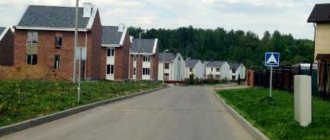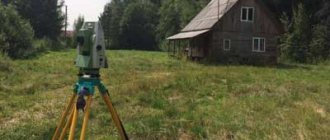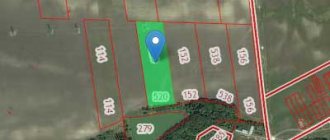There is no clear answer to the question whether it is possible to erect a blind fence on a plot of land between neighboring plots, because SNiP 30-02-97, which regulated the possibility of certain nuances in such a construction at the dacha, was edited twice. In the previous edition, known as SP 53.13330.2019, the construction of a fence between neighbors on a summer cottage was still allowed. This was possible if the construction of a fence of the required height was carried out with the necessary aeration and light penetration. But after a new edition was adopted in 2021, the question of whether it is possible to install a continuous lattice-type fence between neighboring plots in a private house at a dacha is completely denied.
Country cottage area
What is a summer cottage intended for by law?
According to Law No. 217-FZ, the site in SNT is intended only for non-commercial activities of citizens.
This means that they can grow crops on it for their own needs or for recreation. If the grown crop is intended for sale, the owner of the plot may face a fine. Residential and non-residential (outbuilding) buildings can also be erected on the site. At the same time, in residential buildings you can register with SNT (if it is SNT and not ONT).
Note! It is impossible to build permanent houses on the territory of ONT (gardening partnerships).
ConsultantPlus experts talk about the peculiarities of constructing residential buildings on garden plots. Get free trial access to the system and proceed to the explanations. And at this link you can find out how to register at your place of residence at your dacha.
Outbuildings include:
- sheds;
- baths;
- greenhouses;
- awnings;
- wells;
- cellar
If the building is not permanent (does not have a foundation and is not connected to utility networks), then it does not need to be registered with Rosreestr. Capital buildings need to be formalized.
Licenses for wells and wells
According to the new rules, gardeners and summer residents will have to obtain a license for wells and wells. It is not needed only if the well meets the following points:
- owner – an individual;
- it was not drilled into a centralized aquifer;
- used solely for personal interests;
- The amount of water lifted is no more than 100 cubic meters per day.
Since wells meet these requirements, in most cases only wells that are in common use will have to be registered.
What is common property?
Common use property includes objects and equipment located on the territory of SNT or ONT, not related to a specific site and used by all members of the partnership.
Only the general meeting of members of SNT (ONT) has the right to dispose of common property.
In addition to general facilities and equipment, there are also general purpose land plots. How to use them is also decided by the general meeting.
All members of the SNT have the right to use such property on equal terms. But everyone must also pay the same for its maintenance, regardless of whether the particular owner of the site actually used this object.
Roads, driveways, barriers and fire safety measures
After the snow melts and before rainy autumn weather sets in or snow cover appears, people, if their territory is in close proximity to a forest, must carry out cleaning work on it, remove dry grass, crop residues, garbage, etc. at a distance of at least 10 meters from the forest. But there is a second option - they can create a mineralized firebreak at least half a meter from the forest (provided for in paragraph 70).
Pexels Photos
Those dacha areas that are in danger from forest fires must approve a territory passport. This is done annually by the chairman of the SNT. In addition, the SNT administration must take care of the following:
- All driveways must be in good condition so that in the event of a fire you can easily access water sources that can be used to extinguish the fire, for example, a pond (indicated in paragraph 71).
- A barrier or gate should open automatically in case of fire, or manual opening is possible, but only if there is some kind of post that is constantly on duty.
- At the entrance there should be diagrams that indicate entrances, entrances, fire passages and all water sources used during fires.
- If repair or construction work is underway, management is obliged to report the closure of roads and passages, and indicate the detour direction on a special sign (this is paragraph 72).
- If there are natural or artificial reservoirs within a radius of 200 meters, then an access road must also be created to them, a paved road measuring at least 12x12 meters
All of the above requirements will be in force until 2026. All violators will be punished in accordance with Article 2-.4. According to it, the fine for citizens ranges from 2 to 3 thousand rubles, for officials and legal entities - from 6 to 15,000 rubles, and from 150 to 200 thousand, respectively.
Can the board develop its own regulations?
The management of SNT is obliged to develop a charter of the partnership, drawn up taking into account the norms of Law No. 217-FZ. These two documents (charter and law) are sufficient to regulate all aspects of the activities of any SNT. Local documents are not required, since in order to be legal, they in any case must duplicate the provisions of Law No. 217-FZ.
The procedure for payment and the amount of membership fees is also determined by Law No. 217-FZ and the charter. Payments are made only to the bank account.
In order to determine the boundaries of the SNT, there is land management documentation. Please note that only one SNT (ONT) can be created on the territory of one gardening or vegetable gardening area.
At the same time, land owners should keep in mind that joining the SNT is a voluntary procedure. Often this is more profitable for the summer resident himself, but if he does not have such a desire, then no one has the right to force him to join a partnership (Part 6 of Law No. 217-FZ).
To find out what the procedure for becoming a member of a gardening partnership is, follow the link to receive free trial access to K+. And if you want to leave the SNT members, then first find out the consequences of such a withdrawal. To do this, get a free trial access to the system.
Sanitary and construction standards for TSN sites (SNT, ONT, DNP) are regulated by SP 53.13330.2011 (updated version of SNiP 30-02-97) Code of Rules. Planning and development of territories of gardening (dacha) associations of citizens, buildings and structures (approved by Order of the Ministry of Regional Development of the Russian Federation dated December 30, 2010 N 849).
Moreover, compliance with this Code of Rules is included in the “List of Mandatory” - Government Order No. 1047-r dated June 21, 2010, which obliges compliance with the requirements of SP, GOSTs or SNiPs. This list includes some items from the previous edition of SNiP: SNiP 30-02-97* “Planning and development of territories of gardening (dacha) associations of citizens, buildings and structures.” Sections 4 (clauses 4.1 – 4.6, 4.9), 5 (clauses 5.1 – 5.6, 5.10 – 5.13), 6 (clauses 6.1 – 6.4, 6.6 – 6.13), 7, 8 (clauses 8.1 – 8.4, 8.6 – 8.16). According to SNiP 30-02-97 of the Town Planning Code of the Russian Federation, the permitted height of the dividing fence between two sections cannot exceed 1.5 meters. Blind fences cannot be installed; the fence must have gaps so as not to create shadows on the neighbors’ property. Verbatim: 6.2. Individual garden (dacha) plots, as a rule, should be fenced. Fences for the purpose of minimal shading of the territory of neighboring plots should be mesh or lattice (for example, a picket fence) 1.5 m high. It is allowed, by decision of the general meeting of members of the gardening (dacha) association, to install blind fences on the side of streets and driveways. However, in the new edition of SP 53.13330.2011 there are no instructions regarding the height of the fence between neighboring sections of SNT: 6.2. It is recommended to install mesh fencing around the perimeter of individual garden and summer cottage plots. By mutual written consent of the owners of neighboring plots (agreed upon by the board of the gardening and dacha association), it is possible to install other types of fencing. It is allowed, by decision of the general meeting of members of a gardening and dacha association, to install blind fences on the side of streets and driveways. All necessary requirements for the intake of TSN participants (SNT, ONT, DNP) are based on SP 53.13330.2011 and are prescribed in the company’s charter. Therefore, when planning a fence, be sure to read the Charter of your partnership! Before building a fence, we recommend that you agree on the height and parameters of the future fence with your neighbors and the board in writing and make a note in the relevant documents of the gardening or dacha association. What to do if you want to install a high fence? Generally speaking, quarreling and spoiling relations with neighbors is the last thing, you need to avoid this and try to maintain good neighborly relations. However, you may be very unlucky with your neighbors, and then only a high solid fence between the plots will solve your problem. There is a way to do this quite legally: according to the joint venture and the charters of TSN (SNT, ONT, DNP), the fence must comply with their requirements and be installed along the border of the plots. Therefore, if you make a small decorative fence that complies with all the rules for boundaries between plots, and then step back from it 1 meter or more deep into your plot and build a major high solid fence there, which you call a “structure or other structure” - then formally you are nothing don't break it and you'll be right. The step-by-step algorithm for installing a high solid fence in TSN (SNT, ONT, DNP) according to the law is as follows: 1. Demarcate the area, save all documents; 2. Carry out the boundaries of the site in nature. In this case, be sure to demand that boundary signs (pegs) be installed, take more photographs, and save the documents. 3. Install a fence along the border of the site in accordance with all the requirements of the TSN and JV charter. You can allow a small distance of 10–20 cm for measurement error and retreat inside your area by this distance. After installation, take a lot of photographs using a construction and surveyor’s ruler so that you can see the distance along the ruler between the border of the site and the fence. This fence must be done, because... if it is not there, the neighbors can take advantage of the cadastral shift and, through the courts, establish a cadastral error, which is corrected according to the actual position of the fence! Ideally, it is advisable to insure the fence as well! 4. Next, step back 1 meter from the boundary of the plots established by surveyors (more is possible, but not 1 cm less!) and install a blind fence of the height you need. It is very important that there is a distance of at least 1 meter between any part of the solid fence structure and the border. Record everything in the photo. 5. Be sure to save all receipts (or better yet, personalized contracts) for materials and installation of the installed fence. Judicial practice shows that if there is a distance of at least 1 meter from the border of the plots to the fence and this can be proven, i.e. everything is documented (for this we did land surveying, outdoor surveying and a lot of photographs) - there will be no complaints about the fence. If a dispute arises over a distance of 1 meter, request an examination; its cost will be paid by the losing party in court. If they try to dismantle the fence without a court decision, contact the police and then the court for compensation for losses (therefore, all saved documents and contracts will be useful). Neighbors, who are likely to be dissatisfied with this solution to the issue, will have to prove in court that their rights have been violated. In this case, it will be possible to complain only about the violation of insolation and ventilation of the area after installing the fence. But proving this violation in court is very problematic, which is exactly what the next paragraph of the article is about. What to do if a neighbor installed a high fence? It is very difficult to protect your rights from the actions of a neighbor who decided to build a high fence. Theoretically, one can argue that the fence interferes with ventilation, shades your plot and interferes with growing crops, but today there is no regulatory framework to determine the minimum and permissible insolation (illumination, sunlight) of a land plot. What to do, first of all, you should contact the board of a gardening or dacha association with a complaint about violation of fencing standards, which must be prescribed in the charter. If the issue cannot be resolved in this way, go to court, but keep in mind that for a positive decision in your favor, citing a violation of the existing SP 53.13330.2011 and the norms prescribed in the charter of TSN (SNT, ONT, DNP) will most likely not be enough for the court. You will need to go to court with a claim for the demolition of the fence not in accordance with the violation of SNiP, SP or the law, but in accordance with Article 304 of the Civil Code “Protection of the rights of the owner from violations not related to deprivation of possession”: The owner may demand the elimination of any violations of his rights, even if these violations were not associated with deprivation of possession. The most difficult part here will be to prove to the court that the defendant actually violated your rights and legitimate interests by installing the fence. Current laws do not contain standards for illumination and ventilation of a gardening or summer cottage plot, therefore it is impossible to prove that the actual illumination is less than the standard one. But if it can be proven that the shadow from someone else’s fence interferes with growing crops, then, perhaps, the court may take the plaintiff’s side. Measure the amount of harvested crops in previous years, before installing the fence, and this year, i.e. after its construction, it is very difficult, so it is worthwhile in advance, even before going to court, to stock up on evidence, which can include photographs and testimony of witnesses. Thus, when going to court with such claims, you should not rely solely on existing building regulations; you need to carefully prepare evidence to support violations of your rights.
The height of the fence for individual housing construction, private plots, cottage villages according to the law.
Construction on individual housing construction sites is regulated by the Code of Rules for the design and construction of SP 30-102-99 Planning and development of low-rise housing construction areas, but nothing is specified in them about the height of the fence on the individual housing construction site.
Therefore, the parameters of the fence on the individual housing construction site are regulated by the administration of the municipality of the specific locality to which the site belongs. The Moscow Region, based on the same standards SP 53.13330.2011 for SNT, can develop its own rules and regulations, focusing on the climatic and other regional characteristics of the territories.
The necessary information should be found in the General Plan and the Land Use and Development Rules (land use and development rules) of your municipality:
Rules of land use and development (LZZ) - an urban zoning document, which is approved by regulatory legal acts of local governments, regulatory legal acts of state authorities of the constituent entities of the Russian Federation - the federal cities of Moscow, St. Petersburg and Sevastopol and in which territorial zones and urban planning regulations are established , the procedure for applying such a document and the procedure for making changes to it. Before the approval of land use and development rules, public hearings on their project are mandatory.
That. for individual housing construction, the height of the fence is regulated by local legislation, look for the norms in the PZZ on the MO website, or contact the local administration in writing and within 30 working days they must also give you a written response. If there are restrictions on the parameters of the fence, they will need to be taken into account when designing the fence. Here, for example, is an excerpt from the city of Kazan.
If there are no restrictions in the PZZ (this is also possible), then there are none yet, but perhaps they will appear later. This means that you can theoretically isolate yourself from your neighbors with any fence, even a 3-meter fence. However, in order to avoid conflict situations in the future, we recommend that you document your intentions and characteristics of the planned fence with your neighbors in writing and be sure to document the date of installation of the fence.
The height of the fence according to the law in residential areas of settlements, the private sector, and villages.
It is normalized similarly to individual housing construction:
Requirements for fencing land plots in residential areas of populated areas are established by the Land Use and Development Rules of the municipality.
Before starting construction work, it is better to visit the local government office and find out what the maximum height of the fence can be.
Let us repeat, in most municipalities such rules have not been approved. And it’s unclear what will happen next. Therefore, it is advisable to stock up on evidence that the fence was installed before the rules were adopted.
Conclusion:
Don't forget the most important things!
1. Before installing a new fence, be sure to study the requirements for fencing depending on the location of your site. To avoid problems in the future, it is better to obtain written approval from the administration and neighbors before installation.
2. The law does not have retroactive force, so if you installed a fence before its adoption and can prove it (provide installation documents, for example, an installation agreement and a certificate of completion), then the standards prescribed in the new Law do not apply to your fence!
3. It is better to live amicably with your neighbors and always resolve issues peacefully - negotiate! And the agreements reached must be recorded in writing.
In conclusion to the question set out in the article, we suggest that you do not bring the situation to the point of absurdity, but resolve all disagreements with your neighbors peacefully through negotiations, humanly, and do not forget that all the norms, GOSTs, Codes of Rules and SNIPs did not fall from the sky, each letter, every paragraph in them is written with scandals, trials and human tragedies.
Results
If any controversial situations arise regarding participation or non-participation in SNT, you must refer to the provisions of Law No. 217-FZ and the SNT charter. Members of the SNT have the right to use and dispose of common property and bear equal responsibilities for its maintenance. The owner of the site may not join the SNT if he does not have such a desire.
You can find out how land tax is calculated and paid in our “Land Tax” section.
You can find more complete information on the topic in ConsultantPlus. Free trial access to the system for 2 days.
Dacha amnesty from March 1, 2021 to March 1, 2026
The dacha amnesty, which allowed for a simplified registration of houses located on gardening lands, has now been officially extended until 2026 (previously this period was set until March 1, 2021).
Federal Law No. 404-FZ dated December 8, 2020 on the extension of the dacha amnesty also expands its scope. Details about the extension of the dacha amnesty and the scope of its application are in the article: “Dacha amnesty until March 1, 2026.”
Maternity capital will increase
Maternity capital will be indexed by 3.7 percent in 2021. Therefore, the payment for the first child will be 483,882 rubles instead of 466,617 rubles; The payment for the second child will be 639,432 rubles (before indexation it was 616,617), but if the family has already received maternity capital for the first child, then the payment for the second will be 155,550 rubles.
As before, this money will be able to pay for the costs of improving housing conditions, and the new government decree allows it to be spent on rural mortgages.
What causes disputes between neighbors when installing a fence?
The neighbors erected a fence at their own expense and one of the sides of your property turned out to be fenced off. It would seem that you should be happy, not a penny has been spent - but part of the fence is there. However, such a surprise rarely causes positive emotions if it is not agreed upon in advance. Let's assume that the boundaries of the site are not violated - this is already a plus, but the fence may be blank and high. It can shade the area, obstruct the flow of fresh air and become hot from the sun. Are the actions of the neighbor who put up the fence legal in this case?
Or another example: while landscaping your garden plot, you, based on your personal design preferences, spent a lot of time and effort to build a custom decorative fence. You don’t disturb your neighbors, you bought expensive plants and built a hedge - but instead of saying thank you, they complain that weeds are creeping into their plot, and cucumbers do not ripen because of the shade, and they threaten to sue if the fence is not removed.
Let's look at who is right and in what case from the point of view of the law.









